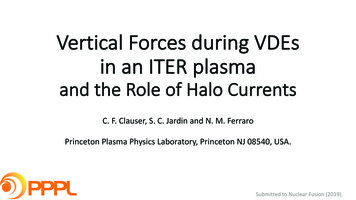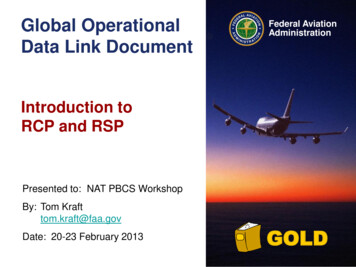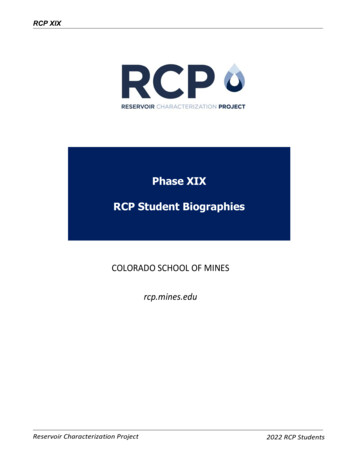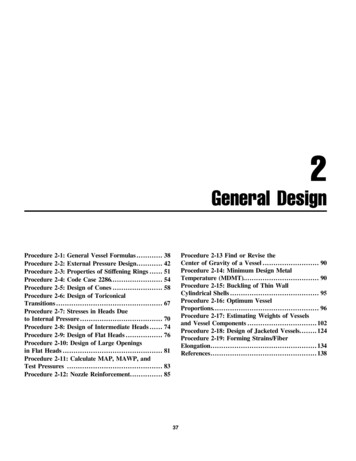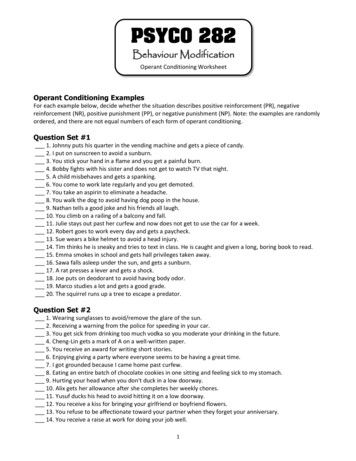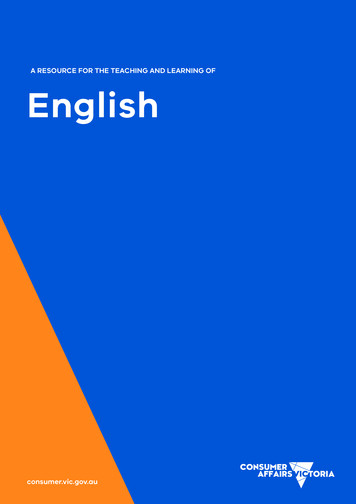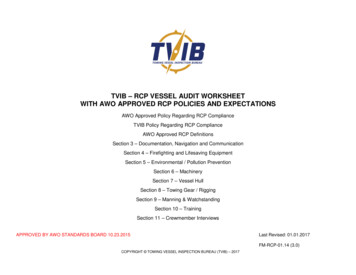
Transcription
TVIB – RCP VESSEL AUDIT WORKSHEETWITH AWO APPROVED RCP POLICIES AND EXPECTATIONSAWO Approved Policy Regarding RCP ComplianceTVIB Policy Regarding RCP ComplianceAWO Approved RCP DefinitionsSection 3 – Documentation, Navigation and CommunicationSection 4 – Firefighting and Lifesaving EquipmentSection 5 – Environmental / Pollution PreventionSection 6 – MachinerySection 7 – Vessel HullSection 8 – Towing Gear / RiggingSection 9 – Manning & WatchstandingSection 10 – TrainingSection 11 – Crewmember InterviewsAPPROVED BY AWO STANDARDS BOARD 10.23.2015Last Revised: 01.01.2017FM-RCP-01.14 (3.0)COPYRIGHT TOWING VESSEL INSPECTION BUREAU (TVIB) – 2017
AWO Approved Policy Regarding RCP ComplianceThe following policy regarding RCP Compliance is being provided tohelp clarify AWO’s position regarding compliance with the RCP inpreparation for use by TVIB to train auditors and instruct them in howto make compliance determinations during RCP audits. In the AWORCP manual we find two paragraphs which provide policy guidancein the introduction to the Management Section on page II-1. Thatguidance is repeated here below in plain text. The items presented initalics are intended to provide clarification for all stakeholders whoare involved in the RCP process.company who are aware of, and trained in, those policiesand procedures which affect their job responsibilities.Companies should develop a mission statement expressing theircommitment to abide by their established policies and proceduresand to ensure employee awareness and knowledge thereof.Third-party auditors should expect to find a written missionstatement that expresses the company’s commitment toabide by their established policies and/or procedures and toensure employee awareness and knowledge thereof.Each towing company should develop and document written policiesand procedures covering at a minimum, those items outlined below(in the RCP). The RCP then goes on to list all of the requiredelements of the Management Section of the RCP.All AWO carrier members, as a baseline, should be in compliancewith all applicable federal laws and regulations concerning marinesafety and environmental protection.Third-Party Auditors who are auditing an RCP managementsystem on behalf of an AWO member company shouldexpect to find written policies, procedures, plans, programs,documented processes, checklists, etc., which cover all therequired items listed in the RCP program manual. Itemsdenoted in the manual as being recommended are onlythere for clarification and the company’s compliance withthese recommended items is optional at the company’sdiscretion.Third-party auditors should expect to find each towingcompany to be in compliance with all applicable federal lawsand regulations concerning Marine Safety andEnvironmental Protection. It seems apparent that applicableFederal Law, USCG and EPA regulations, and any othergovernment regulations which address issues relating toMarine Safety and Environmental Protection should beaddressed by each towing company intending to comply withthe RCP. (See OSHA regulations addressed below)Companies should abide by these policies (and procedures) inconducting their operations and should ensure that their employeesare aware of, and trained in, those policies and procedures whichaffect their job responsibilities.All company policies and procedures should be consistent withapplicable law and regulation and with the guidelines provided in theEquipment and Inspection and Human Factors sections of the AWOResponsible Carrier Program.Third-Party Auditors should expect to find written policiesand/or procedures that describe the company’s expectationsin regard to the subject matter addressed by each policyand/or procedure and should find employees of thatThird-party auditors should expect to find written companypolicies and/or procedures that are consistent withapplicable law and with applicable guidelines provided byAWO throughout the RCP.COPYRIGHT TOWING VESSEL INSPECTION BUREAU (TVIB) – 2017TVIB RCP VESSEL AUDIT WORKSHEET - (1) – 01.01.20171-1
company may deem necessary to ensure the safety andhealth of its employees in the workplace. AWO believes thatsome OSHA standards have considerable value asguidelines for companies wishing to protect employees’safety and health and encourages those companies to usethe OSHA standards as guidelines whenever they appear tobe applicable in their workplace. Note: All other referencesto any specific OSHA Safety and Health standardsthroughout this document are placed there as additionalinformation only and are not to be interpreted as beingthe only OSHA standards that may apply to work beingdone in the member company workplace. In otherwords, these references are not intended to be referredto as an all-inclusive list of OSHA standards.Required procedures are to be documented and implemented.Third-party auditors should expect to find writtendocumentation to show compliance with their companypolicies and procedures. Third-party auditors should beaware that all items listed in the checklists which areprovided for use by third-party auditors are required for acompany to be considered compliant with the RCP.As of theJanuary 1, 2016 revision, recommended practice items haveeither been made required or removed from the checklist;there is no longer any recommended items.Parenthetical items preceded by “e.g.,” (or “for example”) may not beapplicable in all situations and are intended to serve only asexamples of the types of items which company policies andprocedures may address.Compliance with OSHA Safety and Health Standards:While compliance with applicable federal law andgovernment regulations concerning marine safety andenvironmental protection are required by the RCP,compliance with OSHA Safety and Health Standards whichdo not address issues of marine safety or environmentalprotection are left up to the discretion of the membercompany. The one exception to this policy is OSHA’sHazard Communication (Right-to-know) standard. Thisstandard listed in 29 CFR 1910.1200 which is made a part ofthe management section of the RCP.Since OSHA standards in most cases do not address marinesafety or environmental protection issues, the RCP does notrequire those companies intending to comply with the RCPto be in compliance with all OSHA standards. However, it isthe intent of the RCP that each company intending to complywith the RCP should consider all safety and health hazardsthat may impact their employees and take such action as theCOPYRIGHT TOWING VESSEL INSPECTION BUREAU (TVIB) – 2017TVIB RCP VESSEL AUDIT WORKSHEET - (1) – 01.01.20171-2
TVIB Policy Regarding RCP ComplianceThe following policy regarding RCP Compliance is being provided tohelp clarify TVIB’s position regarding auditors’ compliance with theintent of the RCP. This policy is intended to serve as a guide forTVIB to use to train auditors and instruct them in how to makecompliance determinations in accordance with AWO approvedguidelines and interpretations during RCP audits of AWO membercompanies.It is the intention of TVIB that all opinions issued by TVIB CertifiedAWO RCP Auditors involving interpretation of RCP standards are tobe issued in accordance with written guidance approved by theAmerican Waterways Operators. When TVIB discovers that writtenguidance from AWO pertaining to interpretation or understanding ofany RCP standards is not in alignment with a written TVIB policy orinstruction to auditors, TVIB will immediately contact AWO and seekwritten guidance from the appropriate parties within AWO beforecontinuing the process.The policy of TVIB is for TVIB Certified AWO RCP Auditors to followthe instructions issued by TVIB at all times when engaged in makingobjective determinations as to RCP compliance during an RCP auditof an AWO member company.TVIB will endeavor to ensure that there is no conflict between theinformation provided in the AWO “approved” overarching policyregarding compliance with the RCP which immediately precedes thisTVIB policy in this document and the processes, information andtraining materials TVIB will utilize to train and certify TVIB CertifiedAWO RCP Auditors who will be expected to accomplish RCP auditsin accordance with these documents.TVIB will also endeavor to ensure that all training materials, auditorcertification processes, and TVIB developed RCP Audit Tools thatare utilized by TVIB to train and certify TVIB Certified AWO RCPAuditors will be in agreement with the written guidance that iscontained in the AWO approved definitions section of this documentand in the AWO approved RCP Checklists that are also a part of thisdocument and which immediately follow this policy.TVIB will endeavor to continually improve its auditor certificationprocesses and its RCP audit processes in accordance with itsagreement with AWO and will endeavor to remain in compliance withAWO approved documents, definitions, checklists, and writteninstructions at all times.COPYRIGHT TOWING VESSEL INSPECTION BUREAU (TVIB) – 2017TVIB RCP VESSEL AUDIT WORKSHEET - (1) – 01.01.20171-3
AWO Approved RCP Definitions(as of 01/01/2017)The following definitions are being incorporated into the RCP in order to provide consistent guidance for both companies and third-party auditorsas they go about complying with and auditing the RCP. All stakeholders should make themselves familiar with the following definitions. As issuesand questions become known over time, additional definitions will be added to this document.AuthorityThe power or right to give orders, make decisions, and enforceobedience. Essentially, authority is what you can do (as opposedto/compared with responsibility).ConformityThe fulfillment of a requirement. To conform means to meet orcomply with requirements and a requirement is a need, expectationor obligation.Chain GuardsSee definition for safety/guard chains.Controlled DocumentAny document identified by the document control program as beingincluded in the program.Clarity:The ability of a process, idea, concept, or element of a program to becommunicated and understood by the people.Corrective ActionAction to eliminate or mitigate the cause or reduce the effects of adetected nonconformity or other undesired situation.To provide clarity means to provide intent, sufficient detail andspecificity so as to make it easy for something to be communicatedand to be understood by the people in the same context intended bythe writer. A process that has clarity is clearly defined.Critical Equipment and SystemsThose equipment and/or systems, the sudden failure of which mayplace the vessel, crew or environment into a hazardous situation.Compliance with Official Instructions (Maritime Security)Compliance with official instructions in the context of maritimesecurity refers to instructions from an official organization or amember of an official organization during a security related activity orevent. (In the event of a terrorist attack, security related emergencyor threat the USCG or other official organization may communicateinstructions to a towing company or a towing vessel and in that typeof situation, those official communications from official organizationsor individuals must be complied with).Critical Operating Policies and ProceduresThose procedures that are included in the company’s documentcontrol program.Document Control ProgramA documented procedure that applies to the control of all documentsused in the company’s RCP or ISM Safety Management System.This would include all operating policies, procedures, forms andrecords used within the RCP or ISM. The document control programwould include a process for approval, identification, distribution,review, revision and control of obsolete documentation, and alsoinclude records retention. Documents used within the system couldbe in paper, electronic or similar format.COPYRIGHT TOWING VESSEL INSPECTION BUREAU (TVIB) – 2017TVIB RCP VESSEL AUDIT WORKSHEET - (1) – 01.01.20171-4
Documented ProcessA documented process may consist of a written procedure whichimplements a written inspection process which utilizes a writtensafety checklist that contains multiple items. (Typically some, but notall of the items addressed by the safety inspection checklist arerequired by RCP to be addressed in the company’s safety program.The implementing procedure should identify who is responsible forconducting the inspection, identify which safety inspection checklistis to be used for the inspection, outline details concerning conductingthe inspection including frequency of inspection, and describe thecorrective action process to be followed to address non-conformities,follow-up to the corrective actions, and record keeping). Adocumented process, like a written procedure, must close all theloops in the process that is being utilized.Emergency Response TrainingEmergency response training consists of formal hands-on training fortowing vessel crewmembers who are expected to become engagedin carrying out a response to different types of emergency situationsand should address how those crewmembers are expected torespond as they comply with the company’s written emergencyresponse procedures for a particular emergency situation.Emergency Notification (Maritime Security)Emergency notification in the context of maritime security is anynotification required by an official organization or by members of anofficial organization in the event of a security related emergency orsecurity threat.Face Wires, Spring Lines and Push GearThe USCG uses the term face wires, spring lines and push gear todescribe the rigging that is normally used to make up a tow of bargesor to face up the towing vessel to its tow when the towing vessel ispushing ahead or towing alongside. The term spring lines and pushgear might include ratchets, face wires and rigging wires, chain links,shackles and pins, and various sizes and types of synthetic lines.Essentially, all of the rigging components in use on a towing vesseland its tow when underway would fall under the term face wires,spring lines and push gear as used in 33 CFR 164.76(33 CFR 164.76) – The owner, master, or operator of each vesseltowing alongside or pushing ahead shall ensure that the face wires,spring lines, and push gear used----(a) Are appropriate for thevessel’s horsepower; (b) Are appropriate for the arrangement of thetow; (c) Are frequently inspected; and (d) Remain serviceable.Emergency Boat OperationEmergency boat operation is intended to mean operation of any typeof small boat such as a skiff, yawl, or motorboat that may be carriedonboard a towing vessel and may be used during an emergencyresponse to an incident such as a man over board or otheremergency situation as appropriate.Emergency Response DrillsEmergency response drills are hands-on practice which challengetowing vessel crewmembers with a particular emergency situationallowing the crews to practice and demonstrate understanding of,and compliance with the company’s written emergency responseprocedures. (Proper application of emergency response drills shouldresult in a rapid and coordinated response by crewmembers in theevent an actual emergency were to occur. A drill should also providean opportunity to review the requirements of the emergencyresponse procedure. The overall intent of emergency response drillsin the marine environment is to test employee performance inaccordance with a written procedure and to offer an opportunity tocontinually evaluate the integrity of each written emergencyresponse procedure).Great LakesGreat Lakes means the Great Lakes and their connecting andtributary waters including the Calumet River as far as the Thomas J.O'Brien Lock and Controlling Works (between mile 326 and 327), theChicago River as far as the east side of the Ashland Avenue Bridge(between mile 321 and 322), and the Saint Lawrence River as fareast as the lower exit of Saint Lambert Lock. (33 CFR 83.03(m))COPYRIGHT TOWING VESSEL INSPECTION BUREAU (TVIB) – 2017TVIB RCP VESSEL AUDIT WORKSHEET - (1) – 1.01.20171-5
Initial TrainingEach company is expected to define what initial training means tothat company and describe whether it is conducted at the time of hireor within a certain specified time period after the employee has beenhired.(2) Pensacola Bay, Santa Rosa Sound and Big Lagoon from theLight “10” off of Trout Point at Mile 176.9 EHL to the Pensacola FixedBridge at Mile 189.1 EHL.(3) Mobile Bay and Bon Secour Bay from the Dauphin IslandCauseway Fixed Bridge at Mile 127.7 EHL to Little Point Clear atMile 140 EHL.(4) Mississippi Sound from Grand Island Waterway Light “1” at Mile53.8 EHL to Light “40” off the West Point of Dauphin Island at Mile118.7 EHL.(5) The Mississippi River at New Orleans, Mississippi River-GulfOutlet Canal and the Inner Harbor Navigation Canal from thejunction of the Harvey Canal and the Algiers Alternate Route at Mile6.5 West of Harvey Locks (WHL) to the Michoud Canal at Mile 18EHL.(6) The Calcasieu River from the Calcasieu Lock at Mile 238.6 WHLto the Ellender Lift Bridge at Mile 243.6 WHL.(7) The Sabine Neches Canal from mile 262.5 WHL to mile 291.5WHL.(8) Bolivar Roads from the Bolivar Assembling Basin at Mile 346WHL to the Galveston Causeway Bridge at Mile 357.3 WHL.(9) Freeport Harbor from Surfside Beach Fixed Bridge at Mile 393.8WHL to the Bryan Beach Pontoon Bridge at Mile 397.6 WHL.(10) Matagorda Ship Channel area of Matagorda Bay from Range“K” Front Light at Mile 468.7 WHL to the Port O'Connor Jetty at Mile472.2 WHL.(11) Corpus Christi Bay from Redfish Bay Day Beacon “55” at Mile537.4 WHL when in the Gulf Intracoastal Waterway main route orfrom the north end of Lydia Ann Island Mile 531.1A when in the GulfIntracoastal Waterway Alternate Route to Corpus Christi Bay LT 76at Mile 543.7 WHL.(12) Port Isabel and Brownsville Ship Channel south of the PadreIsland Causeway Fixed Bridge at Mile 665.1 WHL. (33 CFR 89.27)Inland WatersInland Waters means the navigable waters of the United Statesshoreward of the navigational demarcation lines dividing the highseas from harbors, rivers, and other inland waters of the UnitedStates and the waters of the Great Lakes on the United States sideof the International Boundary. (33 CFR 83.03(o))Waters upon which Inland Rules 9(a)(ii), 14(d), and 15(b) apply:Inland Rules 9(a)(ii), 14(d), and 15(b) apply on the Great Lakes, theWestern Rivers, and the following specified waters:(a) Tennessee-Tombigbee Waterway.(b) Tombigbee River.(c) Black Warrior River.(d) Alabama River.(e) Coosa River.(f) Mobile River above the Cochrane Bridge at St. Louis Point.(g) Flint River.(h) Chattachoochee River.(i) The Apalachicola River above its confluence with the JacksonRiver. (33 CFR 89.25)Waters upon which Inland Rule 24(i) applies:(a) Inland Rule 24(i) applies on the Western Rivers and the specifiedwaters listed in 33 CFR 89.25 (a) through (i).(b) Inland Rule 24(i) applies on the Gulf Intracoastal Waterway fromSt. Marks, Florida, to the Rio Grande, Texas, including the MorganCity-Port Allen Alternate Route and the Galveston-Freeport Cutoff,except that a power-driven vessel pushing ahead or towingalongside shall exhibit the lights required by Inland Rule 24(c), whiletransiting within the following areas:(1) St. Andrews Bay from the Hathaway Fixed Bridge at Mile 284.6East of Harvey Locks (EHL) to the DuPont Fixed Bridge at Mile295.4 EHL.Internal AuditAn audit performed within an organization to periodically measurecompliance with its safety management system.Internal AuditorThe person or persons who conduct the internal audit of theCOPYRIGHT TOWING VESSEL INSPECTION BUREAU (TVIB) – 2017TVIB RCP VESSEL AUDIT WORKSHEET - (1) – 1.01.20171-6
company. The auditor must meet training and qualificationrequirements as specified by the company and be independent ofthe area being audited, unless it is impractical based on the size ofthe organization.Periodic Drills (Maritime Security)Maritime security drills are required for crewmembers who areemployed onboard towing vessels. The content and frequency ofrequired security drills is specified in the regulations for thosecompanies that operate in accordance with a USCG approvedsecurity plans or USCG acknowledged alternative security programs.Companies who are not required to comply with USCG MaritimeSecurity regulations can determine the scope and frequency ofsecurity drills for its employees, if any.Major Non-ConformityA non-conformity that poses a serious threat to personnel,vessel safety or the environment, and requires immediatecorrective action.Management OfficeAn office that has management oversight of towing vessels.Periodic Training (Maritime Security)Maritime security training is required for crewmembers who areemployed onboard towing vessels. The content and frequency ofrequired training is specified in the regulations for those companiesthat operate in accordance with a USCG approved security plan orUSCG acknowledged alternative security program. Each companycan determine the scope and frequency of security training for itsemployees.Management Review:An evaluation of the management system that a company has inplace that occurs at planned intervals and includes the assessmentof opportunities for improvement through effective objective setting.Near CoastalNear Coastal means ocean waters not more than 200 miles offshore.(46 CFR 10.107)Plan (as in security plan, vessel response plan, etc.)A plan is similar to a program and is a term that is often used inregulatory text. A plan is usually comprised of more than aprocedure, but less than a program. A plan is used to guideperformance and behavior in the accomplishment of a prescribedgoal or task.Near-MissAn event, or sequence of events, that did not result in an injury orincident but which, under slightly different circumstances, could havedone so.PolicyA policy is a high level written document that outlines principles orrules intended to guide decision making and achieve expectedoutcomes. A policy is a statement of an intent. Policy statements areusually implemented by one or more detailed written procedures thatthe company determines are necessary to adequately implement thepolicy.NonconformityAn observed situation where objective evidence indicates the nonfulfilment of a specified requirement.OceanOceans means the waters seaward of the Boundary Lines asdescribed in 46 CFR part 7. (46 CFR 10.107)Opportunity for Improvement (“OFI”)An audit finding of a recommended item that could be improvedupon, but that is not a requirement of the company’s RCPcertification.Preventive ActionAction taken by a company to mitigate the risk of potential issues inan attempt to prevent their occurrence or recurrence.COPYRIGHT TOWING VESSEL INSPECTION BUREAU (TVIB) – 2017TVIB RCP VESSEL AUDIT WORKSHEET - (1) – 1.01.20171-7
ProcedureA procedure is a detailed written document in the form of a step-bystep instruction which is intended to be used by employees toachieve an intended result in a specific situation or over the courseof an activity or event. (Every written procedure should include asmany of the following elements as are appropriate to that procedureand should be written in the same format as other written procedurescontained within the SMS. A written procedure may contain variousheadings such as: purpose, scope, definitions, responsibility,procedure (the procedure itself which may contain numerouselements as needed to describe the company’s expectations for thatprocedure), required training, required records, and a revisionhistory. Other heading terminology may be used to define thestructure of procedures as determined by the company. A writtenprocedure must contain sufficient structure as needed to be able toclose all the loops in the process or activity that is beingimplemented by the procedure).Refresher TrainingEach company is expected to define what refresher training meansto that company and describe the frequency and method forrefresher training as long as all refresher training is conducted atleast once every five years.ResponsibilityThe state or fact of having a duty to deal with something, or havingcontrol over someone. Responsibility is what you must do (asopposed to/compared with authority). When someone is responsiblefor some action or has to take the responsibility for theconsequences of actions, taken either by themselves or bysomebody else for whom they are responsible.Risk AnalysisThe systematic use of information to identify sources and to estimatethe risk.ProgramA high level plan of action defined by a series of detailed writtenprocedures which are aimed at accomplishing clear businessobjectives. (Examples of programs in use in the maritime industryare: Employee Safety & Health Programs, EnvironmentalCompliance Programs, Security Programs, the Responsible CarrierProgram, etc).Risk AssessmentA process that includes identifying hazards and analyzing orevaluating the risk associated with those hazards to determine ifexisting controls are adequate, or if additional controls to eliminate orreduce the risk to an acceptable level to the organization areneeded.RecordsRequired elements of the RCP must be accomplished in anacceptable manner as specified by the company. Complete recordsmust be readily available at the time of an audit and must providesufficient documentation to verify that the company’s expectations forcompliance with a required element were met and that lists thenames of the persons involved in those actions or responsible forhaving taken those actions.Risk Control MeasuresActions or modifications taken to proactively manage, reduce oreliminate risks.Relevant Materials (II.A.3)All policies, procedures, manuals and forms pertaining to themanagement of the RCP or other towing safety managementsystem.Risk ManagementCoordinated activities to direct and control an organization withregard to risk.Risk Identification (sometimes called Risk Discovery)Risk identification is a process to determine, recognize and describethe risks that could affect personnel, vessels the environment andthat are introduced by changes to equipment, staffing or procedures.COPYRIGHT TOWING VESSEL INSPECTION BUREAU (TVIB) – 2017TVIB RCP VESSEL AUDIT WORKSHEET - (1) – 1.01.20171-8
RCP Required TrainingRCP required training is defined as being initial training (training thatoccurs at the time an employee is first hired or at the initialimplementation of the program), and refresher training that mustoccur at least once every five years for each affected employee. Thecompany is expected to include materials and information todescribe their training programs in their written program. It is up tothe company to determine training needs and methods, as long asthe RCP requirements are met and satisfactory training records andcourse information are kept.Scheduled MaintenanceA system of periodic maintenance of or service to equipmentintended to preserve or restore reliability of operation and preventequipment failure. Scheduled maintenance activities are generallyapplied based on some interval of time: hours of operation, daily,weekly monthly, etc. Scheduled maintenance could include but isnot limited to: tests, measurements, adjustments, lubrication or partsreplacement. Scheduled maintenance could occur as reactivemaintenance rather than planned maintenance should indicatorsdevelop requiring unplanned maintenance to correct the defectidentified by the indicator factor; e.g., add water as a result of a lowday/expansion tank level alarm.Safety Chains / Guard ChainsSafety chains are usually provided on towing vessels that do nothave bulwarks around the lower deck perimeter and are typicallyinstalled along the outboard side of the main deck perimeter toprevent a person from falling overboard. Other terms that are alsoused to describe a method for prevention of falls overboard from thelower deck or guard deck of a towing vessel are “guard chains” and“guard ropes” or “safety ropes”.SimpleEasy to understand, deal with, use, etc., presenting no difficulty.SystematicallyGiven to or using a system or method; in a methodical wayUnderstood by EmployeesFor a policy or procedure to be “understood by employees” meansthat employees interviewed had a basic familiarity with thepolicy/procedure and the overall concept(s), if not all of the details ofthe document, procedure or process. Employees with a basicunderstanding should be able to apply a majority of the elements ofthe concept in the workplace.Safety Management Systems (SMS)A comprehensive business management system designed tomanage safety elements in the workplace. (An SMS may incorporatenumerous other components beyond elementary safety and for thetowing vessel industry the requirements addressed by an SMS mayinclude but are not limited to, employee health, environmentalprotection and response, maritime security, company employeeresponsibilities and authorities, resources and personnel, plans andprocedures for towing vessel operations, emergency response,incident investigation and review, maintenance and repair of towingvessels, internal auditing and document control, etc).Well DocumentedTo be well documented means a policy and/or procedure must be inwritten form and be widely disseminated so as to be readily availableto employees in the workplace.Safety RulesWritten safety rules are frequently organized in a list format thatspecifically address multiple safety issues and are intended tominimize or eliminate accidents and injuries in the workplace. Safetyrules may be in any form that a company desires, and must bereadily available to and understood by employees in the workplace.Western RiversWestern Rivers means the Mississippi River, its tributaries, SouthPass, and Southwest Pass, to the navigational demarcation linesdividing the high seas from harbors, rivers, and other inland watersof the United States, and the Port Allen-Morgan City Alternate Route,and that part of the Atchafalaya River above its junction with
Compliance with OSHA Safety and Health Standards: While compliance with applicable federal law and government regulations concerning marine safety and environmental protection are required by the RCP, compliance with OSHA Safety and Health Standards which do not address issues of marine safety or environmental

